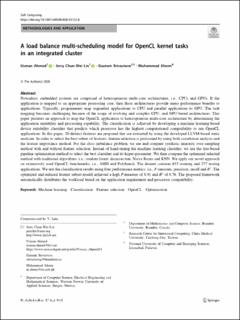| dc.contributor.author | Ahmed, Usman | |
| dc.contributor.author | Lin, Jerry Chun-Wei | |
| dc.contributor.author | Srivastava, Gautam | |
| dc.contributor.author | Aleem, Muhammad | |
| dc.date.accessioned | 2020-11-13T07:31:08Z | |
| dc.date.available | 2020-11-13T07:31:08Z | |
| dc.date.created | 2020-08-27T10:14:54Z | |
| dc.date.issued | 2020 | |
| dc.identifier.citation | Ahmed, U., Lin, J. C.-W., Srivastava, G., & Aleem, M. (2020). A load balance multi-scheduling model for OpenCL kernel tasks in an integrated cluster. Soft Computing. | en_US |
| dc.identifier.issn | 1432-7643 | |
| dc.identifier.uri | https://hdl.handle.net/11250/2687691 | |
| dc.description.abstract | Nowadays, embedded systems are comprised of heterogeneous multi-core architectures, i.e., CPUs and GPUs. If the application is mapped to an appropriate processing core, then these architectures provide many performance benefits to applications. Typically, programmers map sequential applications to CPU and parallel applications to GPU. The task mapping becomes challenging because of the usage of evolving and complex CPU- and GPU-based architectures. This paper presents an approach to map the OpenCL application to heterogeneous multi-core architecture by determining the application suitability and processing capability. The classification is achieved by developing a machine learning-based device suitability classifier that predicts which processor has the highest computational compatibility to run OpenCL applications. In this paper, 20 distinct features are proposed that are extracted by using the developed LLVM-based static analyzer. In order to select the best subset of features, feature selection is performed by using both correlation analysis and the feature importance method. For the class imbalance problem, we use and compare synthetic minority over-sampling method with and without feature selection. Instead of hand-tuning the machine learning classifier, we use the tree-based pipeline optimization method to select the best classifier and its hyper-parameter. We then compare the optimized selected method with traditional algorithms, i.e., random forest, decision tree, Naïve Bayes and KNN. We apply our novel approach on extensively used OpenCL benchmarks, i.e., AMD and Polybench. The dataset contains 653 training and 277 testing applications. We test the classification results using four performance metrics, i.e., F-measure, precision, recall and R2. The optimized and reduced feature subset model achieved a high F-measure of 0.91 and R2 of 0.76. The proposed framework automatically distributes the workload based on the application requirement and processor compatibility. | en_US |
| dc.language.iso | eng | en_US |
| dc.publisher | Springer | en_US |
| dc.rights | Navngivelse 4.0 Internasjonal | * |
| dc.rights.uri | http://creativecommons.org/licenses/by/4.0/deed.no | * |
| dc.subject | machine learning | en_US |
| dc.subject | classification | en_US |
| dc.subject | feature selection | en_US |
| dc.subject | OpenCL | en_US |
| dc.subject | optimization | en_US |
| dc.title | A load balance multi-scheduling model for OpenCL kernel tasks in an integrated cluster | en_US |
| dc.type | Peer reviewed | en_US |
| dc.type | Journal article | en_US |
| dc.description.version | publishedVersion | en_US |
| dc.rights.holder | © The Author(s) 2020 | en_US |
| dc.subject.nsi | VDP::Matematikk og Naturvitenskap: 400::Informasjons- og kommunikasjonsvitenskap: 420::Kommunikasjon og distribuerte systemer: 423 | en_US |
| dc.source.pagenumber | 1-14 | en_US |
| dc.source.journal | Soft Computing - A Fusion of Foundations, Methodologies and Applications | en_US |
| dc.identifier.doi | 10.1007/s00500-020-05152-8 | |
| dc.identifier.cristin | 1825441 | |
| cristin.ispublished | true | |
| cristin.fulltext | original | |
| cristin.qualitycode | 1 | |

